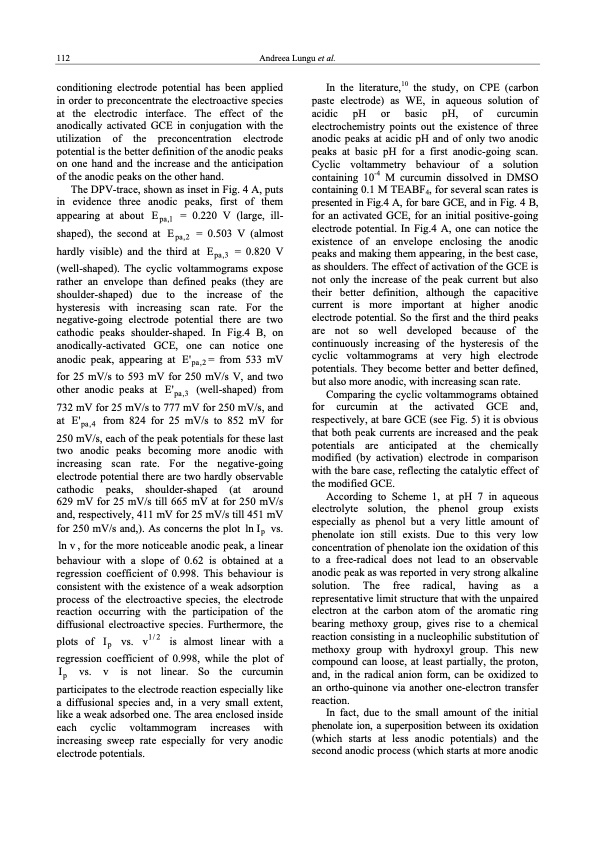
PDF Publication Title:
Text from PDF Page: 004
112 Andreea Lungu et al. conditioning electrode potential has been applied in order to preconcentrate the electroactive species at the electrodic interface. The effect of the anodically activated GCE in conjugation with the utilization of the preconcentration electrode potential is the better definition of the anodic peaks on one hand and the increase and the anticipation of the anodic peaks on the other hand. The DPV-trace, shown as inset in Fig. 4 A, puts in evidence three anodic peaks, first of them appearing at about Epa,1 = 0.220 V (large, ill- shaped), the second at Epa,2 = 0.503 V (almost hardly visible) and the third at E pa ,3 = 0.820 V (well-shaped). The cyclic voltammograms expose rather an envelope than defined peaks (they are shoulder-shaped) due to the increase of the hysteresis with increasing scan rate. For the negative-going electrode potential there are two cathodic peaks shoulder-shaped. In Fig.4 B, on anodically-activated GCE, one can notice one anodic peak, appearing at E'pa,2 = from 533 mV for 25 mV/s to 593 mV for 250 mV/s V, and two other anodic peaks at E'pa,3 (well-shaped) from 732 mV for 25 mV/s to 777 mV for 250 mV/s, and at E'pa,4 from 824 for 25 mV/s to 852 mV for 250 mV/s, each of the peak potentials for these last two anodic peaks becoming more anodic with increasing scan rate. For the negative-going electrode potential there are two hardly observable cathodic peaks, shoulder-shaped (at around 629 mV for 25 mV/s till 665 mV at for 250 mV/s and, respectively, 411 mV for 25 mV/s till 451 mV for 250 mV/s and,). As concerns the plot ln Ip vs. ln v , for the more noticeable anodic peak, a linear behaviour with a slope of 0.62 is obtained at a regression coefficient of 0.998. This behaviour is consistent with the existence of a weak adsorption process of the electroactive species, the electrode reaction occurring with the participation of the diffusional electroactive species. Furthermore, the plots of Ip vs. v1/2 is almost linear with a regression coefficient of 0.998, while the plot of I vs. v is not linear. So the curcumin p participates to the electrode reaction especially like a diffusional species and, in a very small extent, like a weak adsorbed one. The area enclosed inside each cyclic voltammogram increases with increasing sweep rate especially for very anodic electrode potentials. In the literature,10 the study, on CPE (carbon paste electrode) as WE, in aqueous solution of acidic pH or basic pH, of curcumin electrochemistry points out the existence of three anodic peaks at acidic pH and of only two anodic peaks at basic pH for a first anodic-going scan. Cyclic voltammetry behaviour of a solution containing 10-4 M curcumin dissolved in DMSO containing 0.1 M TEABF4, for several scan rates is presented in Fig.4 A, for bare GCE, and in Fig. 4 B, for an activated GCE, for an initial positive-going electrode potential. In Fig.4 A, one can notice the existence of an envelope enclosing the anodic peaks and making them appearing, in the best case, as shoulders. The effect of activation of the GCE is not only the increase of the peak current but also their better definition, although the capacitive current is more important at higher anodic electrode potential. So the first and the third peaks are not so well developed because of the continuously increasing of the hysteresis of the cyclic voltammograms at very high electrode potentials. They become better and better defined, but also more anodic, with increasing scan rate. Comparing the cyclic voltammograms obtained for curcumin at the activated GCE and, respectively, at bare GCE (see Fig. 5) it is obvious that both peak currents are increased and the peak potentials are anticipated at the chemically modified (by activation) electrode in comparison with the bare case, reflecting the catalytic effect of the modified GCE. According to Scheme 1, at pH 7 in aqueous electrolyte solution, the phenol group exists especially as phenol but a very little amount of phenolate ion still exists. Due to this very low concentration of phenolate ion the oxidation of this to a free-radical does not lead to an observable anodic peak as was reported in very strong alkaline solution. The free radical, having as a representative limit structure that with the unpaired electron at the carbon atom of the aromatic ring bearing methoxy group, gives rise to a chemical reaction consisting in a nucleophilic substitution of methoxy group with hydroxyl group. This new compound can loose, at least partially, the proton, and, in the radical anion form, can be oxidized to an ortho-quinone via another one-electron transfer reaction. In fact, due to the small amount of the initial phenolate ion, a superposition between its oxidation (which starts at less anodic potentials) and the second anodic process (which starts at more anodicPDF Image | ELECTROCHEMICAL STUDY OF CURCUMIN on carbon Electrode

PDF Search Title:
ELECTROCHEMICAL STUDY OF CURCUMIN on carbon ElectrodeOriginal File Name Searched:
electrochemical-curcumin.pdfDIY PDF Search: Google It | Yahoo | Bing
CO2 Organic Rankine Cycle Experimenter Platform The supercritical CO2 phase change system is both a heat pump and organic rankine cycle which can be used for those purposes and as a supercritical extractor for advanced subcritical and supercritical extraction technology. Uses include producing nanoparticles, precious metal CO2 extraction, lithium battery recycling, and other applications... More Info
Heat Pumps CO2 ORC Heat Pump System Platform More Info
| CONTACT TEL: 608-238-6001 Email: greg@infinityturbine.com | RSS | AMP |